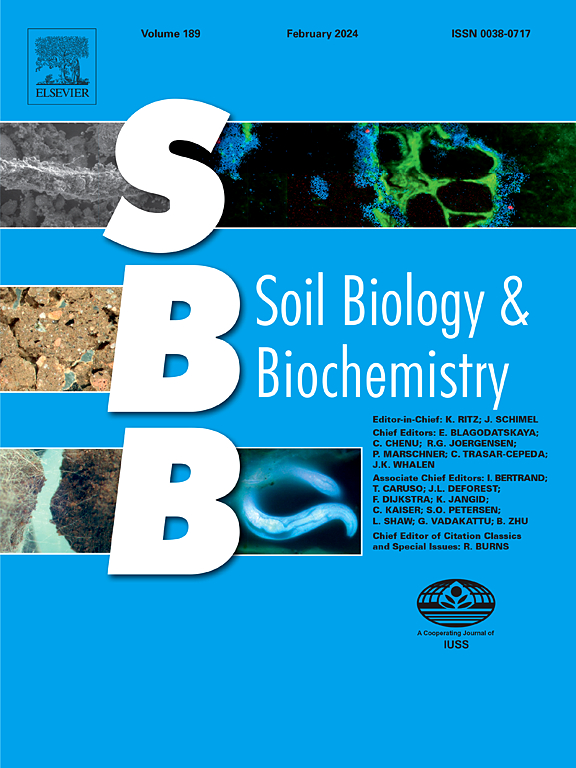微生物生物量估算方法间的相互关系
IF 9.8
1区 农林科学
Q1 SOIL SCIENCE
引用次数: 0
摘要
了解土壤微生物的作用对生态系统过程至关重要,更全面地比较土壤微生物生物量的测量指标可以扩大土壤碳循环和地球系统模型中明确的微生物参数化的范围。我们测量了代表11个主要生物群系和4个气候区的8个土壤目的物理、化学和生物学数据。比较了四种主要的微生物丰度测量方法——氯仿熏蒸提取(CFE)、总DNA产量、定量聚合酶链反应(GCN)基因拷贝数和磷脂脂肪酸(PLFA)——以评估它们之间的相互关系以及与土壤特征的关系。在比较方法时观察到相关性,CFE与总DNA产率、GCN和PLFA密切相关;含细菌GCN和细菌PLFA的CFE;在较小程度上,总PLFA和总DNA产量。相关性随着有机土壤的去除而改善(组织溶胶,凝胶溶胶)。由于在富含粘土的土壤中DNA提取效率低下,通过校正粘土含量来改进涉及提取DNA的比较。涉及真菌(PLFA或GCN)的相关性总是不太显著。这些方法可以作为估计土壤微生物总量的可靠的、相互关联的代理,同时认识到代理在分析细菌和真菌之间的差异方面效果较差。我们提供了具体的方程,通过这四种不同的方法来关联土壤微生物生物量的测量,使微生物模型能够在参数化和模拟中利用更大多样性的观测数据源。对方程及其值的注意事项也进行了讨论。本文章由计算机程序翻译,如有差异,请以英文原文为准。
Interrelationships among methods of estimating microbial biomass across multiple soil orders and biomes
Understanding the role of soil microbes is critical to ecosystem processes, and more thorough comparisons of measurement proxies for soil microbial biomass could broaden the inclusion of explicit microbial parameterization in soil carbon cycling and earth system models. We measured physical, chemical, and biological data from eight soil orders representing 11 major biomes and four climate regions. Four prominent methods to measure microbial abundance—chloroform fumigation extraction (CFE), total DNA yield, gene copy number by quantitative polymerase chain reaction (GCN), and phospholipid fatty acids (PLFA)—were compared to assess their relationships with each other and with soil characteristics. Correlations were observed when comparing methods, with CFE correlating strongly with total DNA yield, GCN, and PLFA; CFE with bacterial GCN and bacterial PLFA; and to a lesser extent, total PLFA and total DNA yield. Correlations improved with the removal of organic soils (Histosols, Gelisols). Comparisons involving extracted DNA were improved by correcting for clay content, due to DNA extraction inefficiencies in clay-rich soils. Correlations involving fungi (PLFA or GCN) were always less significant. These methods could serve as reliable, inter-relatable proxies for the estimation of total soil microbial biomass while recognizing that the proxies are less effective at parsing differences between bacteria and fungi. We provide specific equations to relate measures of soil microbial biomass by these four different methods to enable microbial models to utilize a greater diversity of observed data sources in parameterizations and simulations. Caveats for the equations and their values are also discussed.
求助全文
通过发布文献求助,成功后即可免费获取论文全文。
去求助
来源期刊

Soil Biology & Biochemistry
农林科学-土壤科学
CiteScore
16.90
自引率
9.30%
发文量
312
审稿时长
49 days
期刊介绍:
Soil Biology & Biochemistry publishes original research articles of international significance focusing on biological processes in soil and their applications to soil and environmental quality. Major topics include the ecology and biochemical processes of soil organisms, their effects on the environment, and interactions with plants. The journal also welcomes state-of-the-art reviews and discussions on contemporary research in soil biology and biochemistry.
 求助内容:
求助内容: 应助结果提醒方式:
应助结果提醒方式:


